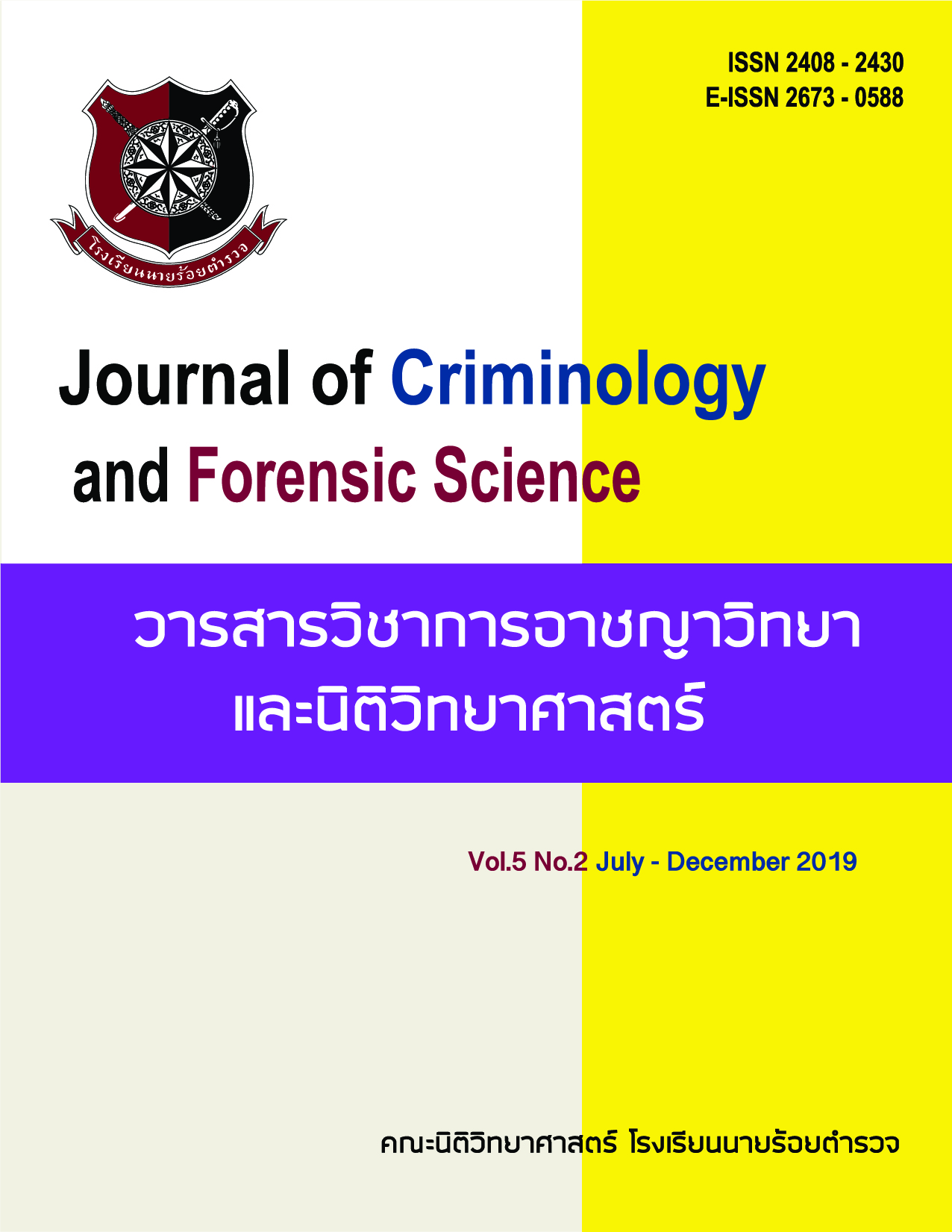การศึกษาเปรียบเทียบการปรากฏของรอยลายนิ้วมือแฝงบนปลอกลูกกระสุนปืน ที่อยู่ในสภาพความชื้นสัมพัทธ์ต่างกัน
Main Article Content
บทคัดย่อ
การวิจัยเรื่องนี้มีวัตถุประสงค์เพื่อศึกษาเปรียบเทียบคุณภาพของลายนิ้วมือแฝงบนลูกกระสุนปืนชนิดทองเหลือง ขนาด 9 มิลลิเมตร โดยวิธีการปัดผงฝุ่นด้วยผงฝุ่นดำ (Black Powder Brushing), วิธีรมแก๊สด้วยซุปเปอร์กลู (Super Glue) และวิธีชุบด้วยสารเคมีเพอร์มาบลู (Perma Blue Treatment) โดยการนำลูกกระสุนปืนที่ประทับรอยลายนิ้วมือแล้วไปเก็บในตู้ควบคุมความชื้นในช่วงสภาพความชื้นสัมพัทธ์ที่ 25% , 50% และ 75% เป็นเวลา 24 ชั่วโมง หลังจากนั้น นำมาตรวจหารอยลายนิ้วมือแฝง
โดยวิธีการทั้ง 3 วิธีเพื่อดูการปรากฏของรอยลายนิ้วมือแฝงบนลูกกระสุนปืนด้วยตาเปล่า
ผลการวิจัยพบว่า วิธีการทั้ง 3 วิธี สามารถทำให้เห็นรอยลายนิ้วมือแฝงบนลูกกระสุนปืน ทองเหลืองขนาด 9 มิลลิเมตร โดยผลการใช้วิธีการปัดผงฝุ่นด้วยผงฝุ่นดำ คิดเป็นร้อยละ 86.67 วิธีรมแก๊สด้วยซุปเปอร์กลู และวิธีชุบด้วยสารเคมีเพอร์มาบลู คิดเป็นร้อยละ 100 หากแบ่งเป็นช่วงความชื้นสัมพัทธ์ที่ 25% พบว่า วิธีการปัดผงฝุ่นด้วยผงฝุ่นดำ สามารถทำให้เห็นรอยลายนิ้วมือแฝงได้ คิดเป็นร้อยละ 60 ส่วนวิธีรมแก๊สด้วยซุปเปอร์กลูและวิธีชุบด้วยสารเคมีเพอร์มาบลู สามารถตรวจพบรอยลายนิ้วมือแฝงได้
คิดเป็นร้อยละ 100 สำหรับช่วงความชื้นสัมพัทธ์ที่ 50% และ 75% สามารถทำให้เห็นรอยลายนิ้วมือแฝงได้คิดเป็นร้อยละ 100 ด้วยวิธีการทั้ง 3 วิธี ดังนั้น จึงสามารถสรุปได้ว่า ความชื้นสัมพัทธ์มีผลต่อรอยลายนิ้วมือแฝงที่อยู่บนลูกกระสุนปืน
Article Details
เนื้อหาและข้อมูลในบทความที่ลงตีพิมพ์ใน วารสารวิชาการอาชญาวิทยาและนิติวิทยาศาสตร์ โรงเรียนนายร้อยตำรวจ ถิอว่าเป็นข้อคิดเห็นและความรั้บผิดชอบของผู้เขียนบทความโดยตรงซึ่งกองบรรณาธิการวารสาร ไม่จำเป็นต้องเห็นด้วยหรือรับผิดชอบใดๆ
บทความ ข้อมูล เนื้อหา รูปภาพ ฯลฯ ที่ได้รับการตีพิมพ์ใน วารสารวิชาการอาชญาวิทยาและนิติวิทยาศาสตร์ ถือว่าเป็นลิขสิทธิ์ของวารสาร วารสารวิชาการอาชญาวิทยาและนิติวิทยาศาสตร์ หากบุคคลหรือหน่วยงานใดต้องการนำทั้งหมดหรือส่วนหนึ่งส่วนใดไปเผยแพร่ต่อหรือเพื่อกระทำการใดๆ จะต้องได้รับอนุญาตเป็นลายลักษณ์อักษรจาก วารสารวิชาการอาชญาวิทยาและนิติวิทยาศาสตร์ ก่อนเท่านั้น
เอกสารอ้างอิง
2. Akejakrawan, S. (2011). Comparison of Time Periods for Latent Fingerprints Detection on Brass Shelling Automatic, Type 9 and 11 Millimeter. Thesis of Master’s degree in Forensic Science Silpakorn University, Nakhon Pathom. (In Thai).
3.Bamrungkit, N. (2008). The Detection of Latent Fingerprint on Cartridge Cases. Thesis of Master’s degree in Forensic Science. Silpakorn University, Nakhon Pathom (In Thai).
4.Champod, C., Lennard C.J., Margot P. and Stoilovic M. (2004). Fingerprints and Other Ridge Skin Impressions. Florida: CRC Press.
5.Chamsuwan, et al. (2003). Forensic Science 2 for Criminal Investigation. 4th. Bangkok. G.B.P.Center. (In Thai).
6.Chuvech, P. (1988). Proof of Firearms and Ammunition. Bangkok. Nitibannakan Publishing. (In Thai).
7.Girelli, C., Lobo, B. & Cunha A. (2015). Comparison of Practical Techniques to Develop Latent Fingermarks on Fired and Unfired Cartridge Cases. Forensic Science International. 250, 17-26
8.Paine, M., Bandey, H.L. & Bleay, S.M. (2011). The Effect of Relative Humidity on the Effectiveness of the Cyanoacrylate Fuming Process for Fingermark Development and on the Microstructure of the Developed Marks. Forensic Science International. 212, 130-142.
9. Reansuwong, T. (2009). The Developing of Latent Fingerprint on .38 Silver Metal Cartridge Cases. Thesis of Master’s degree in Forensic Science Silpakorn University, Nakhon Pathom. (In Thai).
10.Rimrattavichai, S. (1997). The Duration for Detecting Latent Fingerprint by Powder. Thesis of Master’s degree in Forensic Science Mahidol University, Nakhon Pathom. (In Thai).
11.Saenkaew, K. (2009). The Crime Scene Investigation Development of the Police Station in Provincial Police Region 8. Thesis of Master’s degree in Forensic Science Silpakorn University, Nakhon Pathom. (In Thai).
12. Seiun Company Limited Thailand. (1988). Guide of Photographically for Forensic Science. Bangkok. (In Thai).
13. Sinloyma, P. (2017). Solving Crime Problems with Forensic Science. Supporting Documents for Lecture Training Program High-Level Fair Service 8th. Office of Justice Affairs.(In Thai).
14.Thomas,G.L. (1975). The Resistivity of Fingerprint Material. Journal Forensic Science Society. 15(2), 133 -135.


